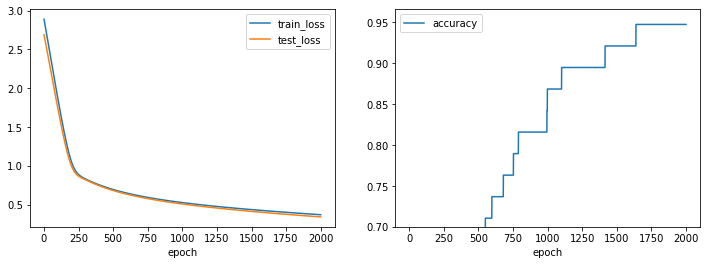100 - Logistic Regression with IRIS and pytorch#
Links: notebook, html, PDF, python, slides, GitHub
First steps with pytorch and Iris dataset.
Note: install tqdm if not
installed: !pip install tqdm
import time
import numpy as np
import pandas as pd
import matplotlib.pyplot as plt
import torch
import torch.nn as nn
import torch.nn.functional as F
import torch.optim as optim
from torch.autograd import Variable
print("torch", torch.__version__)
from torchvision import datasets, transforms
from tqdm import tqdm
from sklearn.datasets import load_iris
from sklearn.preprocessing import LabelBinarizer
torch 1.5.0+cpu
%matplotlib inline
X, Y = load_iris(return_X_y=True)
X = X.astype("float32")
X.shape, Y.shape
((150, 4), (150,))
ftrain = np.arange(X.shape[0]) % 4 != 0
Xtrain, Ytrain = X[ftrain, :], Y[ftrain]
Xtest, Ytest = X[~ftrain, :], Y[~ftrain]
Xtrain.shape, Ytrain.shape, Xtest.shape, Ytest.shape
((112, 4), (112,), (38, 4), (38,))
BATCH_SIZE = 64
TEST_BATCH_SIZE = 64
N_EPOCHS = 2000
class Net(nn.Module):
def __init__(self):
super(Net, self).__init__()
self.fc1 = nn.Linear(4, 3)
def forward(self, x):
x = self.fc1(x)
return F.log_softmax(x, dim=-1)
model = Net()
optimizer = optim.Adam(model.parameters())
loss_fn = nn.NLLLoss()
Xtrain_ = Variable(torch.from_numpy(Xtrain))
Xtest_ = Variable(torch.from_numpy(Xtest))
Ytrain_ = Variable(torch.from_numpy(Ytrain.astype(np.int64)))
Ytest_ = Variable(torch.from_numpy(Ytest.astype(np.int64)))
perfs = []
for t in range(1, N_EPOCHS + 1):
# Before the backward pass, use the optimizer object to zero all of the
# gradients for the variables it will update (which are the learnable weights
# of the model)
optimizer.zero_grad()
# Forward pass: compute predicted y by passing x to the model.
Ypred = model(Xtrain_)
# Compute and print loss.
loss = loss_fn(Ypred , Ytrain_)
# Backward pass: compute gradient of the loss with respect to model
# parameters
loss.backward()
# Calling the step function on an Optimizer makes an update to its
# parameters
optimizer.step()
Ypred_test = model(Xtest_)
loss_test = loss_fn(Ypred_test, Ytest_)
pred = Ypred_test.data.max(1, keepdim=True)[1] # get the index of the max log-probability
accuracy = pred.eq(Ytest_.data.view_as(pred)).cpu().sum().item() / Ytest.size
perfs.append([t, loss.data.item(), loss_test.data.item(), accuracy])
df_perfs = pd.DataFrame(perfs, columns=["epoch", "train_loss", "test_loss", "accuracy"]).set_index("epoch")
f, (ax1, ax2) = plt.subplots(1, 2, figsize=(12, 4))
print("Last accuracy %.3f" % df_perfs.accuracy.iloc[-1])
df_perfs[["train_loss", "test_loss"]].plot(ax=ax1);
df_perfs[["accuracy"]].plot(ax=ax2);
plt.ylim(ymin=0.7);
Last accuracy 0.947
